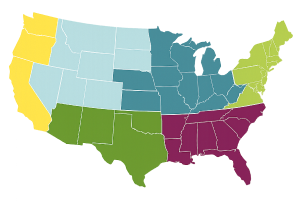
How do we use your location?
Knowing your location helps us recommend plants that will thrive in your climate, based on your Growing Zone.
But when it comes to hybrids, there is really only one group--the world-famous Russell Lupines. They were created by crossing several lupine species, most notably blue L. polyphyllus, a native of the Pacific Northwest. By careful hybridization and years of work, a man named George Russell in England perfected the multicolored strains in 1937, and they've been the standards ever since.
The Gallery Hybrids are considered a dwarf form, since many lupines are very tall plants. Gallery Hybrids grow to only about 18 in an endless array of colors and bi-colors.
Growing Lupines These prized plants are not hard to grow, and in fact, many of the wild species are permanent features in wildflower meadows. (See our Individual Species List for seeds of several native species including Texas Bluebonnet.)
The Russell Hybrids are a bit more fussy. They are best where soils are rich and conditions are cool. In zones 4 and 5 they are fine, but considered a short-lived perennial, even in New England. From Zone 6 south, they grow beautifully, but are hard to preserve and should be planted as annuals.
One of my favorite perennial author/experts, Alan Armitage, says, Flowers more perfect than those of the lupine hybrids are difficult to imagine.
As soon as your order is placed you will receive a confirmation email. You will receive a second email the day your order ships telling you how it has been sent. Some perennials are shipped as potted plants, some as perennial roots packed in peat. The ‘Plant Information’ section describes how that item will ship. All perennials and fall-planted bulbs are packaged to withstand shipping and are fully-guaranteed. Please open upon receipt and follow the instructions included.
Perennials and fall-planted bulbs are shipped at the proper planting time for your Growing Zone. Perennial and fall-planted bulb orders will arrive separately from seeds. If your order requires more than one shipment and all items are shipping to the same address, there is no additional shipping charge. See our shipping information page for approximate ship dates and more detailed information. If you have any questions, please call Customer Service at (802) 227-7200 or contact us by email or chat.